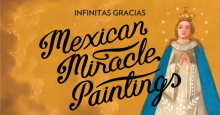Infinitas Gracias: Mexican miracle paintings at The Wellcome Collection

If you cannot face the crowds to snatch a glimpse of the half-dozen Leonardos currently on display at the National Gallery (or need some respite after having done so), head to Euston Road to see a display of some quite different religious painting at the Wellcome Collection.
Infinitas Gracias: Mexican Miracle Paintings documents the Mexican tradition of offering ex-voto paintings in gratitude to saints for answering prayers. There are numerous customs around the world for thanking saints for their intercession; these paintings do so in a very direct way, depicting the moment of need in which the saint was invoked, along with a message of gratitude and devotion.
These are humble paintings, created on metal roof-tiles or other scrap materials, making them accessible to even the poorest families. The miracles they record include curing of illnesses, rescue from drowning, survival of near-fatal falls and even escape from murder. There are over a hundred paintings, dating from the early nineteenth century to the latter half of the twentieth. Most are very simple in style, but nevertheless striking. They are usually narrative illustrations, though a few treat the subject in different way; one recording a road accident resembled a road sign.
Bearing in mind that many visitors will be unfamiliar with the doctrine of the saints, the exhibition would benefit from better explanation of the concept of intercession; the exhibition guide even inaccurately refers to the saints as "deities."
The paintings are contextualised by focus on two places in Mexico where the practice is particularly popular - Guanjuato is home to a shrine to Señor de Villaseca, a manifestation of Christ known as "Christo Negro" (Black Christ), and Real de Catorce is a centre of devotion to St. Francis of Assisi.
There are some powerful videos (short enough not to disrupt the overall experience of the exhibition), including interviews with Mexicans who have experienced a miracle, one documenting the production of a painting.
Among the other offerings on display are milegros, another form of ex-votos, which take the form of pendants in the shape of body parts, worn to invoke protection or healing of the corresponding limb or organ. These are particularly relevant to the Wellcome's medical focus, and provide a connection with the adjacent display, "Felicity Powell, Charmed Life: The Solace of Objects," which is a response by the artist, Powell, to the collection of amulets of the Edwardian folklorist Edward Lovett.
Infinitas Gracias is a window onto a particular manifestation of Catholic piety, as well as a fascinating insight into Mexican life through the stories told in the paintings.
The exhibition runs until 26 February 2012. For more information, exhibition videos, and details of the programme of related events see: www.wellcomecollection.org/whats-on/exhibitions/infinitas-gracias.aspx















